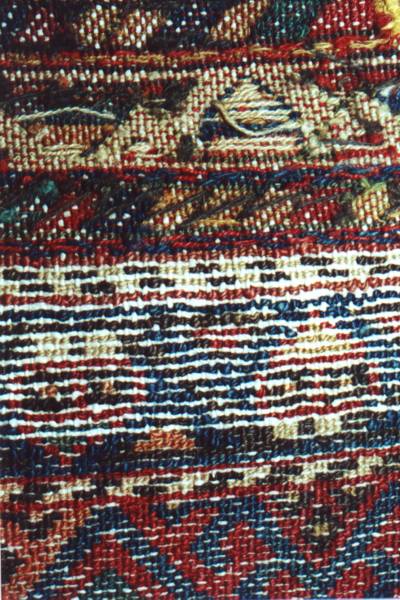
The Salon du Tapis d'Orient is a moderated discussion group in the manner of the 19th century salon devoted to oriental rugs and textiles and all aspects of their appreciation. Please include your full name and e-mail address in your posting.
by Jerry Silverman
There are more than 1,000 books about oriental rugs and countless exhibition and auction catalogs. A rough guess of about 100 pictures per book/catalog would mean that there might be at least 100,000 published pictures, maybe as many as a quarter million. One would think that should be enough to render pretty much any rug or bag easily identifiable - if one interprets “easily” as the willingness to sit and pour through a wall full of books. But, still, it doesn’t always work out that way.
One of the highlights of ACOR V was the final session, which featured a selection of “mystery rugs.” A panel of experts weighed in with their opinions. Members of the audience contributed as well. Even with all that assembled rug wisdom some of the pieces remained mysteries. These were pieces that went well beyond a weaver’s aspirations of creativity.
I doubt that the piece I’ve selected will withstand the collective knowledge of you TurkoTekers. But I’d like you to take a whack at it nonetheless. And while you’re at it, you might also speculate on the process by which major anomalies fall into the crevices of the attribution categorizations collectors try to impose on this field of study. Is it something as simple as a Salor bride marrying into a Tekke family? Or is there more to it? Or were there lots of anomalous weavings at one time, but no one chose to collect them so they were just worn out and discarded leaving only the more easily attributed ones?
Here’s a piece I recently bought on eBay. There was some backchannel discussion of it at the time by some people
who visit this site, but no concensus was achieved.




The piece combines sumak and pile and is 44” wide by 30” long. Structurally, there are three-ply cotton warps and unplyed natural light brown wefts. The selvedge is three warps overwrapped with black goat hair. The pile portion is symmetrical knotted glossy wool. The sumak portion requires someone with a better knowledge of specific techniques to determine (but the photos should show enough detail to supply that information).
The design appears to be some sort of union of the “birds on a pole” (or tessellated as Wendel Swan calls it) motif which appears in the borders and fields of Shahsavan bags and the interlocked diamonds typically seen in Kurdish pieces. Bags which combine sumak and pile are common among the Bakhtiari, but I doubt very much that this is one of theirs. And in saying that we eliminate most of the sumak/pile pieces in the literature. What remains is minimal indeed.

The birds in a border. (From Hegenbart, “Rare Oriental Woven Bags”, Plate 20. Attributed to Homunly [East Moghan - Meshkin, middle Savalan] . Technique: All-over sumak brocading with a transposed foundation weft. Decorative items float partially on the reverse side.)

The birds in the field. (From Tanavoli, “Shahsavan”, Plate 101. Attributed to Bijar area).

More birds in the field. (From Landreau and Pickering, “From the Bosporus to Samarkand”, Plate 101. Attributed
as a Persian bag face. Technique: Alternate stripes of all over sumak brocading and weft-faced complementary weft-float
weave).
After paging through several dozen rug books I was able to find only two non-Bakhtiari bags that had both sumak
and pile fields. Here’s one.

Sumak and pile #1. (From Tanavoli, “Shahsavan”, Plate #209. Attributed to Varamin).
Here’s the other one.

Sumak and pile #2. (From Frauenknecht, “Schahsavan Sumakh Taschen”, Plate #15. Attributed to Shahsavan).
Both of these are khorjin. The pile works as a “rub strip” to absorb abrasion - which appears to make perfect sense
given the way the bags would obviously be used in real life. But what about my mystery rug? The sumak part is about
the size of a mafrash side panel, and yet the pile part isn’t big enough to be the entire bottom of a mafrash.
Finally, just in case you’re wondering, I have taken a close look and am pretty darn sure the two pieces were woven
as a single entity.

So how do we accommodate a Shahsavan sumak with a Kurd pile? Or is it something else entirely?
Cordially,
Jerry